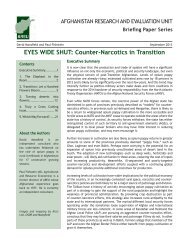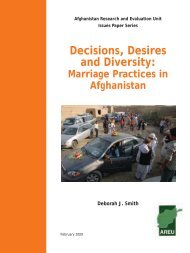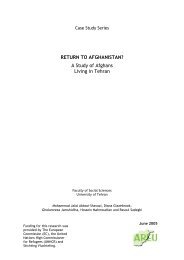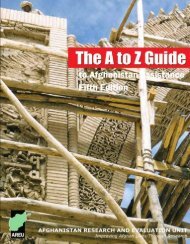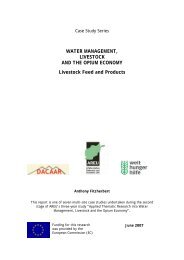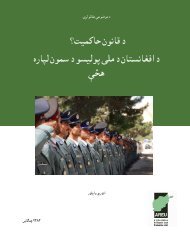Local Governance in Afghanistan: A View from the Ground
Local Governance in Afghanistan: A View from the Ground
Local Governance in Afghanistan: A View from the Ground
- No tags were found...
You also want an ePaper? Increase the reach of your titles
YUMPU automatically turns print PDFs into web optimized ePapers that Google loves.
<strong>Afghanistan</strong> Research and Evaluation Unit<br />
2011<br />
not <strong>in</strong>dependent of government, except <strong>in</strong> <strong>the</strong> DCC approach used <strong>in</strong> Helmand where <strong>the</strong>re is a much<br />
clearer separation of powers between <strong>the</strong> executive and <strong>the</strong> representative bodies. 89<br />
DCC members are selected by draw<strong>in</strong>g upon exist<strong>in</strong>g leadership structures, as noted <strong>in</strong> <strong>the</strong> manual:<br />
“it would not be appropriate to regulate membership to enforce <strong>the</strong> <strong>in</strong>clusion of a specific proportion<br />
of members <strong>from</strong> vulnerable groups <strong>in</strong>clud<strong>in</strong>g women and Internally Displaced Persons.” 90 If women<br />
candidates are elected, <strong>the</strong>y may be members of <strong>the</strong> council. The ASOP manual emphasises that<br />
councillors should be selected by local criteria and that it is <strong>in</strong>appropriate for <strong>the</strong> programme to<br />
dictate to communities which members <strong>the</strong>y should select.<br />
The DCCs were observed <strong>in</strong> Helmand, Wardak and Laghman. In general, <strong>the</strong>y encountered difficulties<br />
associated with <strong>the</strong> lack of clear district structures and some tension between <strong>the</strong> function of <strong>the</strong><br />
DCCs (under IDLG) and <strong>the</strong> DDAs (under MRRD). In Helmand <strong>the</strong> DCC appeared to have eclipsed DDA<br />
operation. In Laghman <strong>the</strong> DCC model had developed <strong>from</strong> a previous tribal shura and had evolved<br />
an approach appropriate to <strong>the</strong> needs of <strong>the</strong> US delivery modalities. In Wardak <strong>the</strong> Taliban had<br />
proscribed <strong>the</strong> DCC. As with <strong>the</strong> prov<strong>in</strong>ce’s DDA members described <strong>in</strong> Section 5.5, DCC councillors<br />
were under threat of death and did not reveal <strong>the</strong>mselves, while those that were known to <strong>the</strong><br />
Taliban chose to reside <strong>in</strong> Kabul. Dur<strong>in</strong>g <strong>the</strong> period of <strong>the</strong> study <strong>the</strong> Wardak DCC programme was thus<br />
essentially <strong>in</strong> hiatus with <strong>the</strong> exception of DCCs <strong>in</strong> <strong>the</strong> Hazara districts of Behsud 1 and 2, which were<br />
outside <strong>the</strong> Taliban sphere of <strong>in</strong>fluence.<br />
The DCC model that has emerged <strong>in</strong> Helmand is dist<strong>in</strong>ctively and <strong>in</strong>terest<strong>in</strong>gly different <strong>in</strong> approach.<br />
In each district a council has been established through a process of consultation and election. Initially,<br />
this <strong>in</strong>volved discussions between technical advisors, ASOP staff and a range of actors <strong>in</strong> each district<br />
<strong>in</strong>clud<strong>in</strong>g <strong>the</strong> woluswal, prov<strong>in</strong>cial council members and o<strong>the</strong>r prov<strong>in</strong>cial and district notables, with<br />
<strong>the</strong> aim of carv<strong>in</strong>g districts <strong>in</strong>to constituencies. Several hundred men were <strong>the</strong>n ga<strong>the</strong>red <strong>from</strong> across<br />
<strong>the</strong> district by means of public announcement and registered to nom<strong>in</strong>ate and elect candidates for<br />
each constituency of <strong>the</strong> district. By this means a form of constituency-based competitive election<br />
took place that resulted <strong>in</strong> a DCC. After tra<strong>in</strong><strong>in</strong>g, it met at least twice monthly and was <strong>in</strong>volved <strong>in</strong><br />
plann<strong>in</strong>g, prioritisation, resource allocation and monitor<strong>in</strong>g of DDP funds (see Section 5.6 for more<br />
details) and <strong>in</strong> oversight of an expanded local civil service. As <strong>in</strong> o<strong>the</strong>r ASOP councils, <strong>the</strong> DCC had<br />
three sub-committees. However, <strong>in</strong> a reversal of established practice <strong>the</strong> woluswal was accountable<br />
to <strong>the</strong> DCC and reported regularly to it. Decision mak<strong>in</strong>g and horse trad<strong>in</strong>g <strong>in</strong> <strong>the</strong> DCC was tak<strong>in</strong>g<br />
place much as <strong>in</strong> any o<strong>the</strong>r political context.<br />
Significantly, <strong>the</strong>re was also an <strong>in</strong>tegrative element to <strong>the</strong> approach. In Nad Ali District (Helmand)<br />
it was noted how several councillors had to receive Taliban permission to stand as representatives<br />
and <strong>the</strong> local Taliban ensured that DCC meet<strong>in</strong>gs were be<strong>in</strong>g recorded. And <strong>in</strong> Musa Qala, where <strong>the</strong><br />
economy is heavily dependent on poppy, it was evident that some of those elected were closely<br />
l<strong>in</strong>ked to <strong>the</strong> Taliban.<br />
A fur<strong>the</strong>r form of district representation was observed <strong>in</strong> Laghman where <strong>the</strong> <strong>the</strong>n wali, Ghulab<br />
Mangal (now wali of Helmand), recognised <strong>the</strong> need for district representation. In 2007, he formed a<br />
qawmi (tribal) shura of 45 to 70 members <strong>in</strong> each district, composed of maliks, ulema, elders, CDC<br />
heads and DDA members. These shuras played an important role <strong>in</strong> dispute resolution, and became<br />
<strong>the</strong> body of preference for solv<strong>in</strong>g all but <strong>the</strong> most trivial cases. They were able to communicate with<br />
<strong>the</strong> militant elements <strong>in</strong> <strong>the</strong>ir district and were <strong>in</strong>volved <strong>in</strong> poppy reduction. They met monthly to<br />
discuss security issues and current disputes and cooperated with <strong>the</strong> woluswal and chief of police.<br />
However, <strong>the</strong>y were also prepared to compla<strong>in</strong> openly about issues such as corruption. The shuras<br />
received $200 per month for expenses paid for by Mangal. Although <strong>the</strong>y have s<strong>in</strong>ce been absorbed<br />
<strong>in</strong>to <strong>the</strong> ASOP shuras, <strong>the</strong> formation of <strong>the</strong>se qawmi shuras was significant s<strong>in</strong>ce it demonstrates how<br />
Afghan adm<strong>in</strong>istrators are aware of <strong>the</strong> value and need for district representation.<br />
89 “Field Operations Manual for <strong>the</strong> implementation of <strong>the</strong> <strong>Afghanistan</strong> Social Outreach Programme” (Kabul: IDLG/AECOM/<br />
USAID, 2011), 7.<br />
90 “Field Operations Manual,” 13.<br />
<strong>Local</strong> <strong>Governance</strong> <strong>in</strong> <strong>Afghanistan</strong>: A <strong>View</strong> <strong>from</strong> <strong>the</strong> <strong>Ground</strong><br />
45



